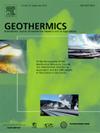帕米尔高原东北缘地热资源分析
IF 3.5
2区 工程技术
Q3 ENERGY & FUELS
引用次数: 0
摘要
中国帕米尔高原东北缘位于青藏高原西北部,靠近印亚俯冲带。该地区构造活动强烈,大地热量高,地下水丰富,形成极具潜力的高温地热系统。通过综合水化学、同位素、挥发性气体、放射性成因元素分析等数据来源,结合区域构造和地质资料,提出了局部地热成因模型。沿深断裂渗透的融雪水和大气降水与深部岩浆水混合,经岩浆、花岗岩放射性元素、断裂摩擦和少量地幔热流加热,形成深部母物质热流体(370℃)。母质热流体不断膨胀上升,溶解周围岩石矿物,形成多个浅层和深层热储(111.68℃~ 260.96℃)。地热储层中的流体在压差的驱动下再次上升,绝热冷却后形成A组高温热水。由于热水向上运移,侧向流入次级断层,发生混合冷却和传导冷却,形成B组和C组中低温水。研究区内形成了B组和C组的中低温热水。由于冷水混合程度不同,C组热水Ca2+和HCO3-离子含量较b组高,露头温度较b组低,推测地热水补给高度为3810 ~ 5540 m,补给来源主要为融雪水和大气降水。这些发现表明了一个多面的热源体系,包括地壳放射性热产生、熔融岩浆热、构造摩擦热和地幔热流。本文章由计算机程序翻译,如有差异,请以英文原文为准。
Analysis of geothermal resources in the northeast margin of the Pamir plateau
The northeastern margin of the Pamir Plateau in China is situated in the northwestern Tibetan Plateau, proximity to the Indo-Asian subduction zone. The region is characterized by intense tectonic activity, high terrestrial heat and abundant groundwater, contributing to the formation of an extremely promising high-temperature geothermal system. By integrating various data sources, including water chemistry, isotopes, volatile gases, and radiogenic element analysis, with regional structural and geological data, a local geothermal genetic model is proposed. The snowmelt water and atmospheric precipitation infiltrated along the deep fault are mixed with the deep magmatic water, and heated by the magma, granite radioactive elements, fracture friction and a small amount of mantle heat flow to form the deep parent material thermal fluid (370 °C). The parent material thermal fluid continues to expand and rise, dissolves the surrounding rock minerals, and forms multiple shallow and deep thermal reservoirs (111.68 °C-260.96 °C). The fluid in the geothermal reservoir rises again under the driving of pressure difference, and forms Group A high temperature hot water after adiabatic cooling. As the hot water migrates upward and laterally flows into the secondary fault, mixed cooling and conduction cooling occur, resulting in the formation of Group B and C medium and low temperature water. In the study area, medium and low temperature hot water of Groups B and C are formed. Due to the different degree of mixed cold water, Group C hot water shows relatively higher content of Ca2+ and HCO3- ions and lower outcrop temperature compared with Group B. The recharge height of the geothermal water is inferred to be 3810–5540 m, and the recharge sources are mainly snowmelt water and atmospheric precipitation. These findings suggest a multi-faceted heat source regime, encompassing crustal radioactive heat generation, molten magma heat, tectonic frictional heat, and mantle heat flow.
求助全文
通过发布文献求助,成功后即可免费获取论文全文。
去求助
来源期刊

Geothermics
工程技术-地球科学综合
CiteScore
7.70
自引率
15.40%
发文量
237
审稿时长
4.5 months
期刊介绍:
Geothermics is an international journal devoted to the research and development of geothermal energy. The International Board of Editors of Geothermics, which comprises specialists in the various aspects of geothermal resources, exploration and development, guarantees the balanced, comprehensive view of scientific and technological developments in this promising energy field.
It promulgates the state of the art and science of geothermal energy, its exploration and exploitation through a regular exchange of information from all parts of the world. The journal publishes articles dealing with the theory, exploration techniques and all aspects of the utilization of geothermal resources. Geothermics serves as the scientific house, or exchange medium, through which the growing community of geothermal specialists can provide and receive information.
 求助内容:
求助内容: 应助结果提醒方式:
应助结果提醒方式:


